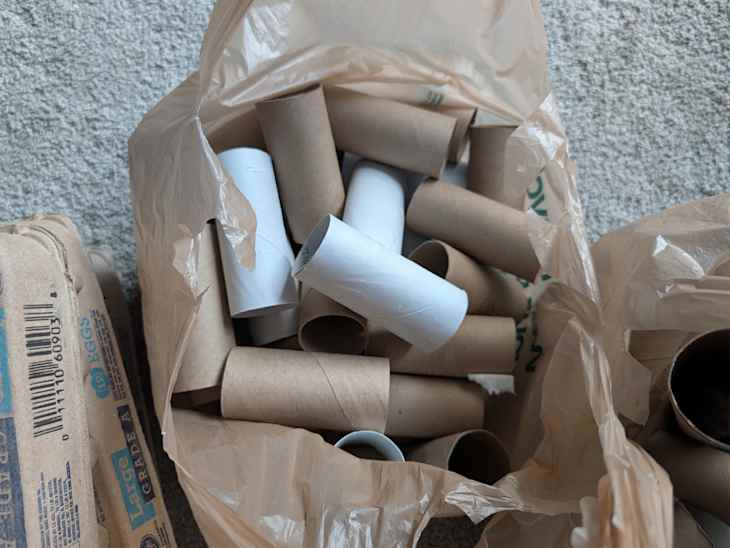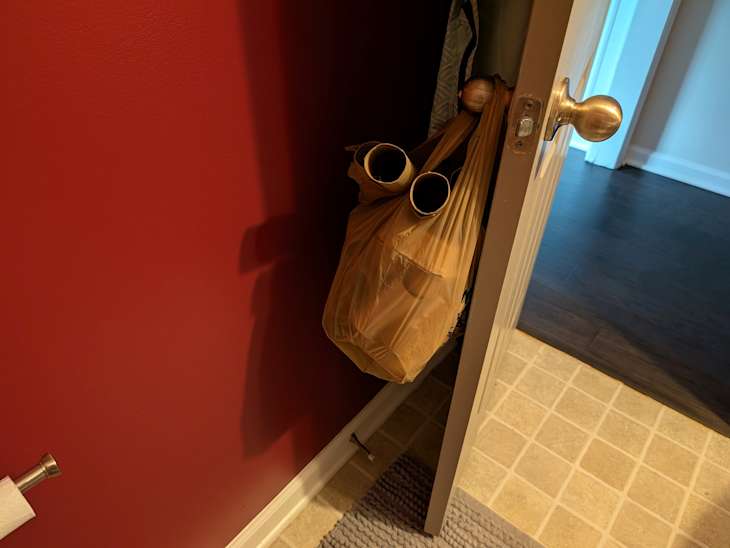

You’d be hard-pressed to find any group of people more ingenious about upcycling than those who pour their passion into a cause. I’ve been actively volunteering with animal shelters in Atlanta’s LifeLine Animal Project network and Smyrna, Georgia-based neonatal orphaned puppy rescue Bosley’s Place for years now, and their resourcefulness never ceases to amaze me. It’s humbling to see how much their operational teams manage to achieve with so little personnel and funding.
It’s also enlightening and surprising how creatively they manage to turn — to the naked eye — nothing into something: Like turning paper towel and toilet paper tubes into DIY enrichment toys for animals. In fact, I haven’t thrown out a single one of these now in three years!

How Saving Paper Towel and Toilet Paper Tubes Helps Your Community
What I’ve learned working in animal shelters that really broke my heart is that many of the dogs put on euthanasia lists aren’t there because they’re necessarily aggressive or problematic. Of course, it’s almost always a space issue, but many of these pups end up there because they’re sad. It’s often the most sensitive ones that are the most vulnerable as the stress, noise, confusion, and (I’m not kidding) lack of cuddles begins to deteriorate their mental health, causing them to become depressed.
“Due to overwhelmingly high intake numbers, our shelter staff and volunteers are outnumbered by shelter pets in need of physical and mental stimulation,” Meera Solomon, director of Volunteer Services at LifeLine, explains. “The sad reality is that most shelter dogs spend the vast majority of their day kenneled with little interaction,” which makes the distraction and challenge of enrichment toys a critical part of keeping their stress regulated — and hopes high.
At home (and well-funded shelters), these are often Kongs, puzzle feeders, snuffle mats, and other thought-provoking toys. But at city or town shelters like LifeLine, creative volunteers make easy — potentially life-saving — enrichment toys by upcycling paper towel and toilet paper tubes, turning them into fully edible, no-waste, no-choke, low-cost toys.
How to Upcycle Your Empty Cardboard Tubes
Creating these DIY enrichment toys is easy and takes only about three minutes to assemble per tube. At LifeLine, volunteers fold in the edges of each tube for loose closure, then fill the tubes with treats and kibble. They then close the other end the same way. Dogs then have to figure out how to open the tubes to access the snacks, and get the fun of tearing up pet-safe paper. How fast or slow they do it is up to them! (You can find full step-by-step instructions here.)
“Being able to provide something safe in their kennels to help enrich their day can make a big difference in their quality of life while they wait for a home,” Solomon says. “Making enrichment for shelter pets out of items that often end up in the recycling bin makes supporting the shelter pets in your community accessible to people of all backgrounds,” she adds, making it effortless to do good for the dogs and the planet as you reduce waste.
Before you start making your own or saving tubes in your home, check with your local animal shelter first. While most shelters use enrichment toys and whatever treats are donated, some may prefer specific types of both. Some may also prefer to have their volunteers or staff members assemble DIY enrichment toys within the facility to ensure animal safety as well. Petfinder is a great resource for finding local shelters near you.

But if you want to start collecting, it’s simple to start. I keep a shopping bag hanging on my bathroom door handles that I fill with clean, lightweight tubes over time before donating them to the shelter en masse. I love that it invites questions from guests, who then often start saving them themselves! If you have space under your bathroom or kitchen sink, that’s also a great collection spot.
And if your shelter doesn’t accept them, you can still give these paper tubes a second life as a dog toy. “It’s not just for shelter pets!” Solomon says. “Pets at home benefit from using species-specific behaviors like licking, chewing, sniffing, and shredding to relieve stress and boredom, too,” making them perfect solutions for soothing anxiety or easing them into time alone at home. No pets at home? Try out this trick for creating DIY cord organizers with your leftover tubes.